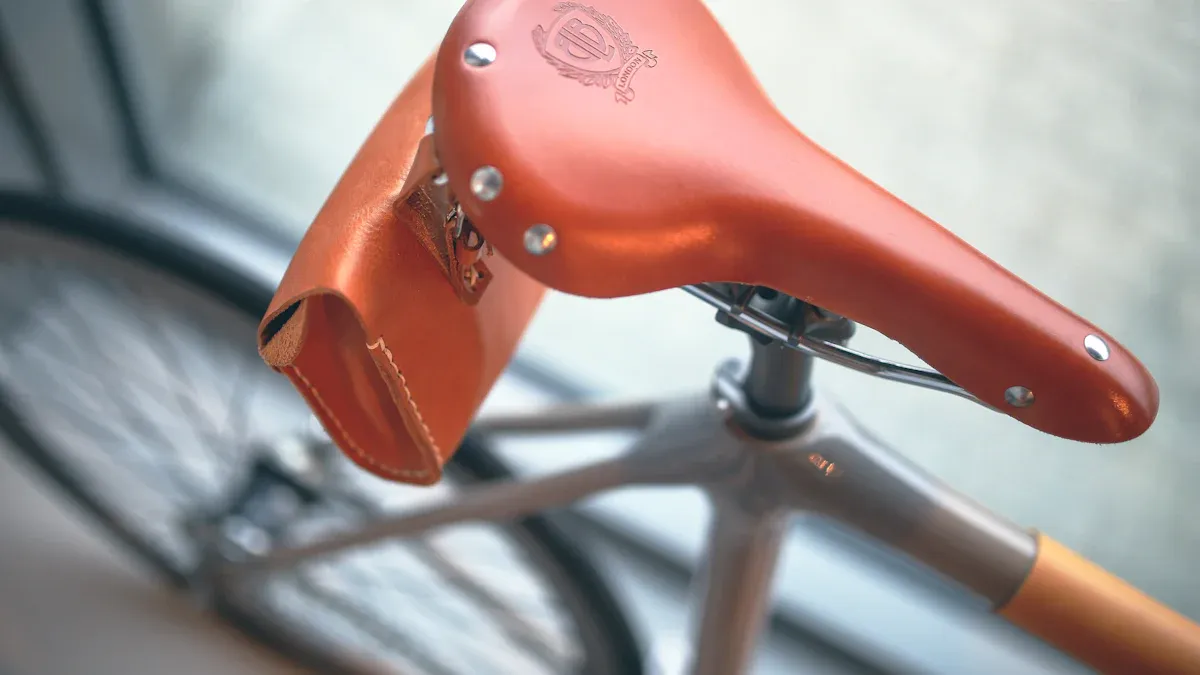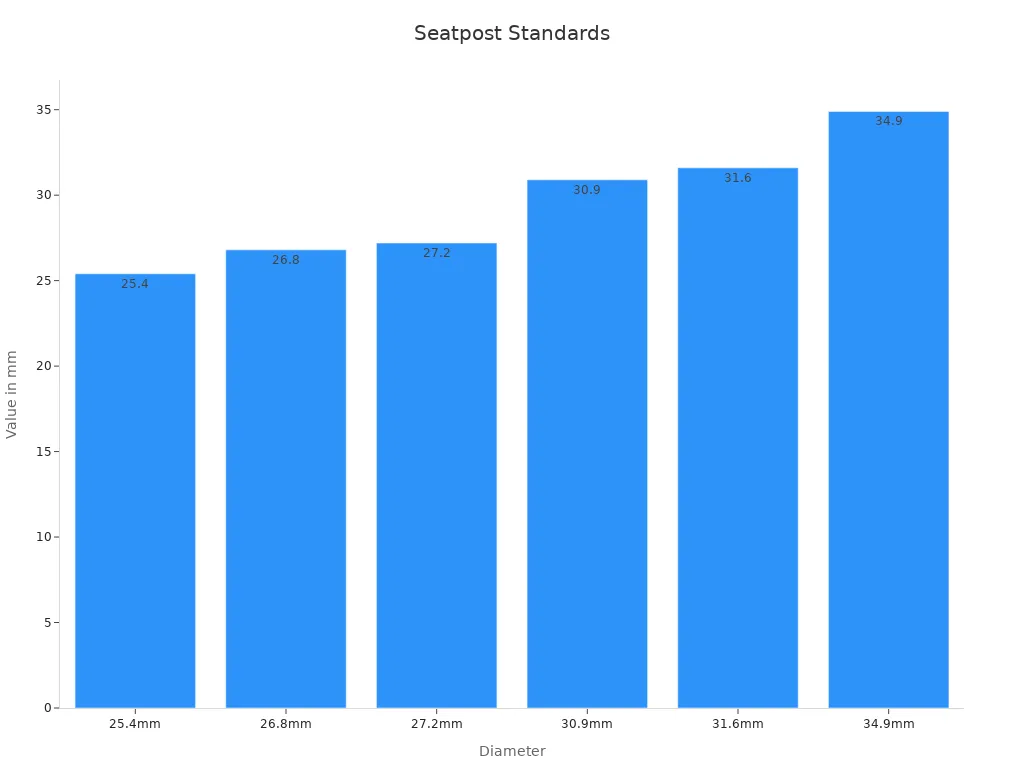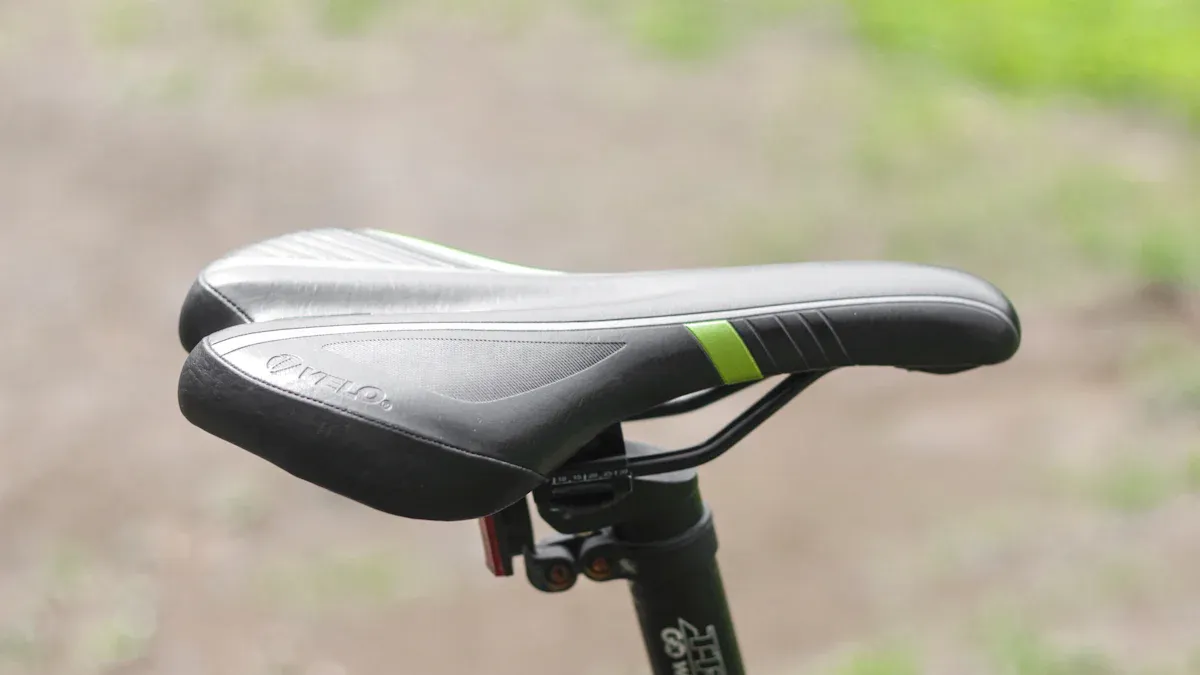
You spend a lot of time on your bike seat, so choosing the right bike seat post matters. The seat holds you in place and affects both comfort and how well you ride. A good bike seatpost supports your seat and helps you find the best position. If you want great performance and comfort, you need a seat that fits your needs. The seat post connects your seat to your bike, and the right choice can make every ride smoother and more enjoyable.
Key Takeaways
Pick a bike seat post that matches how you ride and your bike type. This helps you feel more comfortable and in control. Measure your bike’s seat tube width carefully. This helps you choose the right seat post size. The right size stops slipping or damage. Change your seat height, angle, and setback to find the best spot for riding. This can help stop pain or tiredness. Choose seat post materials like aluminum if you want it strong. Pick carbon fiber if you want it lighter and smoother. Keep your seat post clean. Check it often for any damage. This keeps you safe and helps your bike last longer.
Types of Bike Seat Posts
When you look at bike seatposts, it can seem confusing. Each type has special features and good points. Let’s look at the main choices so you can pick what works for you.
Rigid Seat Posts
Rigid seatposts are the most common kind on bikes. They have a straight shape and no moving parts. You set the height, tighten it, and you can ride. These seatposts are light and easy to take care of.
You feel every bump and dip because the seatpost is stiff.
Rigid seatposts are made from aluminum or carbon fiber. Carbon fiber ones are lighter and can soak up some shakes.
Many road bikes, like Aeroad and Ultimate, use rigid seatposts for better speed and power.
Tip: If you ride on smooth roads or want a light bike, a rigid seatpost is a good pick.
Suspension Seat Posts
Suspension seatposts make rides smoother by soaking up shocks from rough roads. They use springs or special shapes to let the seatpost move up and down. This helps your body feel less tired on long rides.
Here’s how suspension seatposts are different from rigid ones:
Canyon Endurace bikes use the S15 VCLS 2.0 suspension seatpost. It gives you 20mm of up-and-down movement to smooth out bumps.
The carbon leaf spring design keeps the ride firm on smooth roads but soft on rough ground.
Suspension seatposts help you feel less tired by cutting down on bumps.
Some people find that suspension seatposts make the seat higher, which can be hard for shorter riders.
The Cane Creek Thudbuster ST series is popular because you can change how stiff it is and pick different sizes.
Check out the table below for comfort features:
Feature | Description | Comfort Benefit |
|---|---|---|
Lets the seatpost move up and down | Cuts down on bumps, so you feel less tired | |
Proprietary parallelogram design | Keeps the seatpost moving while you pedal | Always absorbs shocks, so you get more comfort and control |
Infinitely adjustable stiffness | Lets you change it for your weight and style | Makes the ride just right for you and helps you feel less tired |
User reviews | Riders say it feels smoother and shakes less | Shows that it really helps with comfort |
Note: Suspension seatposts need the same care as rigid ones. Keep them clean and check for damage. Most of the time, you do not need extra work.
Dropper Seatposts
Dropper seatposts are great if you ride on tricky trails. These seatposts let you change your seat height while you ride. You use a lever on your handlebars to move the seat up or down. You can lower the seat for steep hills or raise it for flat ground without stopping.
Dropper seatposts help you:
Lower your body for better control on tough trails.
Change your seat height fast to match the ground.
Stay safe and feel sure of yourself, especially on mountain bike trails.
Many riders like dropper seatposts because they make it easy to handle sudden changes. You do not have to stop and fix your seat by hand. Just press the lever and the seat moves. This is very helpful for mountain bikers, but more road and gravel riders are starting to use dropper posts too.
If you want more control and options, dropper seatposts can make your ride smoother and more fun.
When you look at all the types of bike seatposts, think about where you ride and what feels best for you. Each seatpost type gives you something special, so you can choose what fits your needs.
Pivotal Seat Posts
You might notice pivotal seat posts most often on BMX bikes, but they have started to show up on other types of bikes too. If you want a simple and strong way to attach your saddle, this design could work for you. The pivotal seatpost uses a special system with teeth on both the post and the saddle. You line up the teeth, pick your angle, and then tighten a single bolt from the top. That’s it—no fuss, no extra tools.
Here’s why you might like a pivotal seatpost:
Easy Adjustments: You can change your saddle angle quickly. Just loosen the bolt, tilt the saddle, and tighten it again. No need to mess with tricky clamps or extra hardware.
Strong and Reliable: The teeth lock together and hold your saddle in place. You don’t have to worry about the saddle slipping, even if you land hard or ride rough trails.
Clean Look: The bolt sits on top, so the seatpost looks neat and tidy. You won’t see extra parts sticking out.
Tip: If you ride BMX or do tricks, a pivotal seatpost gives you the strength and easy adjustments you need. You can set your saddle low for jumps or tilt it for comfort.
Let’s compare pivotal seat posts to other types:
Feature | Pivotal Seat Post | Standard Seat Post |
|---|---|---|
Adjustment | Quick, single bolt | May need two bolts |
Strength | Very strong | Varies |
Looks | Clean, simple | Can look bulky |
Common Use | BMX, some mountain bikes | Road, mountain, hybrid |
You might not see pivotal seatposts on every bike, but they offer real benefits if you want a tough and easy-to-use option. If you like to ride hard or want to change your saddle angle often, this seatpost could be your best pick. You get a secure fit and a clean style without extra weight.
Remember, not all saddles fit a pivotal seatpost. Make sure your saddle matches before you buy one.
Key Features to Consider
If you want your bike to feel good, you need to look at some important things before you pick a seatpost. These things help you stay comfortable, safe, and ride better. Let’s talk about what matters most.
Diameter and Compatibility
Getting the right bike seatpost diameter is very important. If you pick the wrong size, your seat might move or get stuck. It could even hurt your bike frame. You want your seat to stay put, even on bumpy rides.
Most bikes use standard seatpost sizes, but there are many different diameters. The most common bike seatpost diameters are 27.2mm, 30.9mm, and 31.6mm. You might also see 25.4mm, 26.8mm, or 34.9mm. Always check your bike’s manual or use a caliper to measure the inside of your seat tube.
Here’s a quick look at the most common bike seatpost diameters and how to measure them:
Factor/Aspect | Details/Standards |
|---|---|
Standard Seatpost Diameters | 25.4mm, 26.8mm, 27.2mm, 30.9mm, 31.6mm, 34.9mm (common sizes standardized by manufacturers) |
Measurement Method | Use precise tools like Vernier or digital calipers to measure the internal diameter of the seat tube |
Measurement Steps | 1. Remove seatpost 2. Measure internal diameter of seat tube 3. Record diameter (e.g., 27.2mm) |
Insertion Depth | Must respect frame markings for minimum and maximum insertion for safety and adjustability |
Offset/Setback | Horizontal distance between seatpost centerline and saddle mount; affects rider position and comfort |
Angle Adjustment | Fixed by frame size; affects saddle horizontal position and pedaling efficiency |
Material Influence | Aluminum, carbon fiber, steel, titanium alloys affect strength, weight, shock absorption, and compatibility |
Diameter Range | Typically from 22mm to 35mm in 0.2mm increments; 27.2mm is most common for road and gravel bikes |
Compatibility Note | Seatposts are not universal; must match frame seat tube diameter and type (e.g., dropper posts) |

Your seatpost should fit tightly in your bike frame. If it’s too loose, it can slip. If it’s too tight, it can get stuck or break the frame. Always double-check the bike seatpost diameter before you buy. Some bikes need special seatpost sizes, so don’t guess.
Tip: If you don’t know your seatpost size, ask your local bike shop. They can measure it and help you get the right one.
Length and Insertion Depth
The bike seatpost length is also important. You need enough seatpost inside the frame to keep it safe. You also need enough sticking out to set your seat at the right height. If your seatpost is too short, you could break your frame or the post. If it’s too long, you might not be able to lower your seat enough.
Most seatposts have a line that shows the minimum insertion. You should always keep at least this much inside the frame. For example, some aluminum seatposts need at least 90mm inside the tube. This keeps your bike strong and safe, especially if you ride hard or hit bumps.
Here’s a table to help you understand how seatpost length and insertion depth work:
Parameter | Details |
|---|---|
Material | 6061 aluminum |
Minimum Insertion Length | 90mm (e.g., Zipp Service Course Seatpost) |
Adjustability | 2-bolt adjustability |
Design Considerations | Short insertion length enables longer travel options, important for smaller frames, curved seat tubes, and frames with bottle bosses |
When you pick a seatpost, think about your height and your bike type. Road bikes, mountain bikes, and gravel bikes all use different seatpost sizes and lengths. The right seatpost length lets you adjust your seat for the best fit. If you have a small frame or a curved seat tube, you might need a shorter seatpost or a special design.
Note: Always look for frame markings that show the minimum and maximum insertion depth. This helps you avoid damage and keeps your ride safe.
Setback and Saddle Positioning
Setback, or offset, is the space between the middle of the seatpost and where your saddle clamps on. This small thing can change how you feel on your bike. The right setback helps you find the best riding position and keeps your knees, hips, and back feeling good.
If your saddle is too far forward, your knees or upper body might hurt. If it’s too far back, your hamstrings or lower back could hurt. Many riders use the KOPS method to check their saddle position. Your knee should line up with the pedal spindle when the crank is at 3 o’clock. This helps you pedal better and avoid injuries.
Studies show that saddle setback changes how your muscles work and how your weight sits on the bike. If you get the setback right, you can ride longer and feel better. You might need to change your seat height when you change the setback, so always check both.
Pro Tip: Try small changes in setback and see how your body feels. Even a few millimeters can make your ride much more comfortable.
When you look at all these things—bike seatpost diameter, seatpost length, insertion depth, and setback—you see how each one affects your comfort and performance. You want a seatpost that matches your seatpost size, fits your bike, and lets you adjust your seat for the best position. Don’t forget to think about the material, too. Aluminum, carbon fiber, and titanium all change the weight, strength, and shock absorption of your seatpost. If you want a lighter ride or less shaking, carbon fiber might be best.
Here’s a quick list of what to check before you buy:
Make sure the bike seatpost diameter matches your frame.
Pick the right seatpost length for your height and bike type.
Check the minimum insertion depth for safety.
Choose the right setback for your riding style and comfort.
Look for ergonomic features like angle adjustability and easy fore-aft adjustment.
Think about the material for weight, strength, and vibration damping.
Make sure your seatpost fits your saddle shape and cutouts, as well as your saddle width.
A good seatpost helps you get the most from your bike. It keeps your seat in the right spot, supports your body, and lets you ride longer without pain. When you pay attention to seatpost sizes, seatpost dimensions, and ergonomic features, you get a smoother, safer, and more fun ride.
Angle Adjustability
When you ride, the angle of your seat can make a big difference. If your seat tilts too far forward or back, you might feel pain in your back, hips, or knees. You want your seat to support you in the right way, so you can pedal with power and stay comfortable.
Many modern seatposts let you adjust the angle of your seat with small, precise changes. You can use a seatpost with a two-bolt system, like the Bontrager Comp Seatpost. This design lets you fine-tune the angle of your seat. You get micro-adjustment, which means you can set your seat just how you like it. This helps you find the best spot for your body and riding style.
Some seatposts, like the Whisky Parts Co. No. 7 Alloy Seatpost, let you adjust the seat angle with your fingers. You do not need special tools. You can make quick changes before a ride or even during a break. This makes it easy to get your seat in the perfect position.
Dropper seatposts, such as the X-Fusion Manic Dropper, use a double bolt clamp. This gives you a wide range of seat angle adjustment. You can set your seat for steep climbs or fast descents. The seat stays stable, even when you ride hard.
Here are some features you might find on adjustable seatposts:
Micro-adjustment lets you set your seat angle exactly where you want it.
Two-bolt or double bolt clamps hold your seat steady.
Some seatposts allow finger adjustment for quick changes.
Wide adjustment range helps you match your seat to any ride.
Tip: Try small changes in your seat angle. Even a tiny tilt can make your ride feel much better.
When you look for a new seatpost, check how easy it is to adjust the seat angle. This feature can help you avoid pain and ride longer. You want your seat to work with your body, not against it.
Materials and Weight
The material of your seatpost changes how your bike feels. It also affects how much your bike weighs and how much shock you feel from the road or trail. You have a few main choices for bike seatpost materials: aluminum and carbon fiber are the most popular. Some riders also use titanium or steel, but these are less common.
Let’s compare the main options:
Aspect | Aluminum Seat Posts | Carbon Fibre Seat Posts | Seat Post Diameter Impact |
|---|---|---|---|
Material Properties | Durable, budget-friendly | Lightweight, better vibration absorption | Smaller diameters (e.g., 27.2mm) offer flexibility and vibration dampening |
Weight Impact | Heavier, adds durability | Lighter, enhances bike performance | Larger diameters (e.g., 30.9mm, 34.9mm) provide increased strength and stiffness |
Ride Quality | Reliable performance, especially for mountain biking | Smoother ride favored by road cyclists | Diameter affects stiffness, comfort, and support |
Cost | More affordable | More expensive | N/A |
Typical Use | Mountain biking, rough terrain | Road cycling, long rides | Mountain biking and dropper posts often use larger diameters |
Length Influence | N/A | N/A | Length affects saddle height adjustment and comfort, with longer posts for mountain bikes and shorter for road bikes |
Aluminum seatposts are tough and do not cost much. They work well if you ride on rough trails or want a seat that can take a beating. These seatposts add a bit of weight, but they last a long time.
If you want a lighter bike and a smoother ride, you might look for the best carbon bike seatpost. Carbon fiber seatposts soak up more bumps and shakes. This means your seat feels softer, especially on long rides. Many road cyclists pick the best carbon bike seatpost for comfort and speed. These seatposts cost more, but they can make your bike feel faster and easier to handle.
The diameter of your seatpost also matters. A smaller diameter, like 27.2mm, can flex more and absorb shocks. This makes your seat feel less harsh. Larger diameters, such as 30.9mm or 34.9mm, give you more strength and stiffness. These are good for mountain bikes or dropper seatposts, where you need extra support.
When you choose bike seatpost materials, think about your riding style. If you ride on smooth roads, a carbon fiber seatpost can make your seat feel great. If you ride on rocky trails, an aluminum seatpost gives your seat more strength. Always check the weight and size to match your bike and your needs.
Note: The right seatpost material can change how your seat feels every time you ride. Pick the one that matches your comfort and performance goals.
How to Measure and Adjust a Seat Post

Measuring the Diameter of Your Seat Tube
Getting the right bike seatpost diameter is the first step for a good fit. If you use the wrong size, your seat might slip or get stuck. You can measure the inside of your seat tube with a caliper. Take a few measurements at different spots and average them for the most accurate result. Most bikes use standard sizes like 27.2mm, 30.9mm, or 31.6mm, but some brands use special sizes. Always check your bike’s manual or ask the manufacturer if you’re not sure.
Use a caliper to measure the inside diameter of your seat tube.
Take several measurements and average them.
Make sure the seatpost is just a bit smaller than the seat tube—about 0.1mm less.
Check for any special sizing or proprietary designs.
Tip: If you don’t have a caliper, your local bike shop can help you find the right bike seatpost diameter.
Determining the Correct Length
Choosing the right seat post length keeps you safe and comfortable. You want enough post inside the frame for strength, but enough sticking out for proper height adjustment. The seat tube angle, usually between 71 and 75 degrees, affects how you sit and pedal. If your frame is too small, the seat post might stick out too far. If it’s too big, you might not get the saddle low enough. Always follow the minimum and maximum insertion marks on your seat post.
Parameter | Description | Typical Values / Notes |
|---|---|---|
Bottom bracket to top of seat tube | Varies by frame size | |
Seat Tube Angle | Angle of seat tube | 71–75 degrees |
Seat Post Length | Length of seat post | Must not exceed safety limits |
Frame Size Impact | Too small or large frame affects seat post extension | Proper sizing is critical |
Note: Proper sizing means matching your seat post length to your frame and your body for the best fit.
Adjusting Saddle Height and Angle
You can make your ride much better by adjusting your saddle height and saddle tilt. Start by loosening the seat clamp. Raise or lower the seat post until your leg has a slight bend at the bottom of the pedal stroke. Many riders use the LeMond method: multiply your inseam by 0.883 to find the distance from the bottom bracket to the top of the saddle. You can also check your knee angle—it should be between 25 and 35 degrees when your foot is at the lowest point.
Adjust the height so your knee is slightly bent at the bottom of the pedal stroke.
Tighten the clamp to the right torque.
Adjust the saddle forward or back for comfort.
Set the saddle tilt so it’s level or just slightly angled for your comfort.
A good fit helps you ride longer and avoid pain. If you feel discomfort, try small changes in saddle height or tilt.
Ensuring Proper Insertion Depth
Getting the right insertion depth for your seat post keeps your bike safe and your rides smooth. If you don’t insert your seat post deep enough, you risk damaging your bike frame or even hurting yourself. You want to make sure your seat post sits far enough inside the frame to handle bumps, jumps, and everyday riding.
Why does insertion depth matter?
When you ride, your weight and the road’s bumps put a lot of force on the seat post. If you don’t insert it deep enough, the seat tube can crack or bend. You might also feel the seat post slip while you ride. That’s never fun!
How do you check insertion depth?
Most seat posts have a line marked “minimum insertion.” You should always keep this line hidden inside the frame. If you see the line, push the seat post down more. Here’s a quick checklist to help you:
Look for the minimum insertion line on your seat post.
Slide the seat post into the frame until the line disappears.
Tighten the seat clamp to the recommended torque.
Double-check that the seat post feels solid and doesn’t move.
Tip: If your seat post doesn’t have a line, a good rule is to keep at least 3–4 inches (about 75–100mm) inside the frame.
Here’s a simple table to guide you:
Seat Post Material | Minimum Insertion Depth |
|---|---|
Aluminum | 90mm |
Carbon Fiber | 100mm |
Steel | 70mm |
If you ride a mountain bike or do jumps, you might want even more insertion for extra strength.
Remember, never force a seat post past the maximum insertion mark. That can damage your frame. Always check your bike’s manual for special instructions.
Keeping the right insertion depth helps you ride safer and keeps your bike in top shape. Don’t skip this step!
Choosing Based on Riding Style
When you pick a seatpost, think about how you ride. If you like smooth roads, a rigid seatpost works well. It is light and simple. For bumpy trails, a suspension seatpost helps a lot. It makes your ride softer and less tiring. If you ride on steep hills or tricky paths, a dropper seatpost is best. You can change your seat height fast with a lever. BMX riders often use pivotal seatposts. These are strong and easy to adjust. Each type of seatpost fits a different riding style. Pick the one that matches how and where you ride. This way, you will feel comfortable and safe every time you get on your bike.
Recommendations for Racers and Competitive Cyclists
If you race or ride competitively, you want every part of your bike to help you go faster. The seat post can make a big difference. You need something light, strong, and easy to adjust. You also want to keep your comfort high, even when you push hard.
Here are some tips to help you pick the best seat post for racing:
Choose a carbon fiber seat post. Carbon is light and helps absorb road buzz. This means you feel less tired and keep your comfort during long races.
Look for a seat post with micro-adjustment. You can set your saddle angle just right. Even a small change can boost your comfort and power.
Pick a seat post with the right setback. Many racers use a zero or small setback to get a more aggressive position. This helps you pedal harder and faster.
Make sure the seat post fits your bike frame. Check the diameter and length. A good fit keeps you safe and helps you ride better.
Go for a seat post with a simple clamp design. You can swap saddles or make changes quickly before a race.
Pro Tip: Test your seat post setup before race day. Ride on different roads and check your comfort. If you feel pain or numbness, try small changes in saddle height or angle.
Here’s a quick table to help you compare features:
Feature | Why It Matters for Racers |
|---|---|
Carbon Material | Lowers weight, boosts comfort |
Micro-Adjustment | Fine-tunes saddle for best fit |
Proper Setback | Improves power and comfort |
Secure Clamp | Keeps saddle stable at high speed |
You want to focus on speed, but never forget comfort. A good seat post lets you ride longer and recover faster. When you feel good on your bike, you can give your best at every race.
Maintenance Tips
Cleaning and Lubricating the Seat Post
Keeping your seat post clean helps your bike last longer and ride smoother. Dirt and grit can sneak into the seat tube and cause scratches or even make the post stick. You should wipe down your seat post every few weeks, especially if you ride in the rain or on muddy trails. Take out the seat post, clean it with a soft cloth, and check for any grime. For metal seat posts, add a thin layer of bike grease before you put it back. If you have a carbon seat post, use carbon assembly paste instead. This keeps the post from slipping and stops creaks.
Tip: If you ride a lot in wet or muddy places, clean your seat post more often. This simple habit can save you from bigger problems later.
Checking for Wear and Damage
You want your seat post to stay strong and safe. Look for cracks, deep scratches, or any bending. Pay close attention to the area near the clamp and the part that goes inside the frame. If you see any sharp edges or the post feels loose, it might be time for a closer look. Modern seat posts, especially dropper posts, have become much more reliable. Recent tests show that new dropper posts can last months without trouble, even after heavy use. Some models, like the Turnon Bunker Dropper Post, keep working well for up to 300 hours before needing service. That means you can trust your seat post to handle tough rides, but you should still check it now and then.
When to Replace Your Seat Post
Sometimes, cleaning and checking are not enough. If you spot a crack, a big dent, or if your seat post keeps slipping, you should replace it. Don’t wait for a failure on the trail or road. If your seat post has been in use for many years, or if you ride in harsh conditions, think about swapping it out as a safety step. Newer seat posts last much longer than older ones, thanks to better designs and stronger materials. Still, nothing lasts forever. If you feel unsure, ask your local bike shop for advice.
Keeping your seat post in good shape means you ride safer and enjoy your bike more. Regular care goes a long way! 🚲
Choosing the right bike seat post changes how you feel every time you sit on your bike. Your seat should match your riding style and bike type. When you set your seat height and angle just right, you help your knees and joints stay healthy. A good bike seat post lets you adjust your seat for comfort and better pedaling. You also spread your weight across the seat, which keeps you steady and safe. Remember to check your bike seatpost often. Clean it, adjust your seat, and look for any damage. This way, your seat stays strong and you enjoy every ride.
FAQ
How do I know if my seat post fits my bike?
You need to check the diameter of your seat tube. Use a caliper to measure it. Most bikes use sizes like 27.2mm or 31.6mm. If you feel unsure, ask your local bike shop for help.
Can I use any saddle with any seat post?
Not always. Some seat posts, like pivotal or certain dropper posts, need special saddles. Most standard seat posts fit most saddles, but always check the clamp style before you buy.
How often should I clean and check my seat post?
You should clean and inspect your seat post every few weeks, especially after riding in rain or mud. Look for dirt, scratches, or cracks. Keeping it clean helps your bike last longer.
What should I do if my seat post keeps slipping?
First, make sure you have the right size. Clean both the seat post and the inside of the seat tube. Tighten the clamp to the correct torque. If it still slips, try assembly paste or visit your bike shop.
Is a carbon seat post better than aluminum?
Carbon seat posts feel lighter and absorb more bumps. Aluminum seat posts cost less and last longer on rough trails. Pick the one that matches your riding style and comfort needs.


